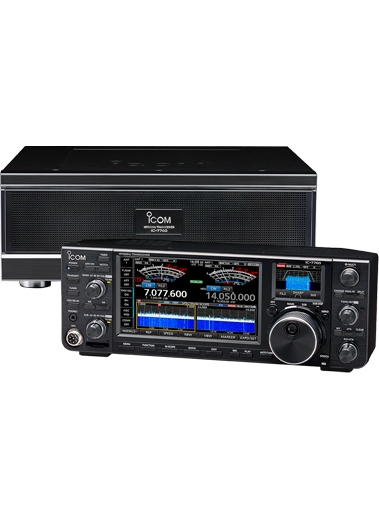A New Innovative Shack Style
In today’s connected world, the IC-7760 introduces a new connected system consisting of a control head and an RF deck, connected over the Internet or a home LAN network (Wired or Wi-Fi®). This concept increases the flexibility of your station installation, making more space available on the desktop by placing the RF deck in a location closer to the antenna feed point. In addition to the direct connect feature, you can place the RF deck at your remote HF station and operate a full-scale remote with the control head at your home. For example, it enables you to operate a club station with the control head at your home.
Full Control Head With Separated Control Head
The IC-7760 consists of a separate control head and RF deck and uses a control cable for connecting between them. It increases the flexibility of the installation. A control cable (3 m, 9.8 ft) is supplied with the transceiver, and a commercially available LAN cable* can be used to install the RF deck in a more remote location. It enables the RF deck to be placed in a rack or other location away from the station desktop, providing a quiet shack environment away from the noise of the fan used to dissipate the heat generated by the RF deck. *Commercially available LAN cables can also be used: Cat5e or higher. 100 m, 328 ft (Max.) For the same low-latency performance as a direct connection between RF deck and the control head, Gigabit Ethernet is recommended for the home LAN connection.
Remote Operation over the Internet
The IC-7760 offers remote operation over the Internet* or a home LAN connection (Wired or Wi-Fi®). This setup enables you to place the radio in your radio shack and operate a full-scale remote with the control head at a separate location. Even with network delay or jitter, the IC-7760 adjusts its buffer to ensure precise signal transmission and CW keying. The optional RC-7760 Remote Controller is available as an additional control head. Up to five control heads can be registered to the RF deck, only one of the control heads connects to the radio and takes control at a time. Commercially available Wi-Fi® access points can be connected to the LAN port for a wireless connection.
* Internet connection requires stable speeds of at least 10 Mbps from RF deck to control head, and at least 5 Mbps from control head to RF deck. A VPN connection or Port Forwarding using with either a global static IPv4 address or dynamic DNS (DDNS) is necessary for Internet access. Restrictions may apply depending on network configuration. Brief audio dropouts may occur due to packet loss.
Dual Independent Receivers
The IC-7760 has independent MAIN/SUB receivers, from the antenna to the speaker, so that one receiver section has no effect on the other, providing simultaneous reception of two signals in different bands/modes with identical performance. As with the IC-7851, dual spectrum scopes provide simultaneous display of the MAIN and SUB bands allowing the operator to see the changing band conditions.
Advanced RF Direct Sampling System
The IC-7760 adopts the RF direct sampling system, in which RF signals are directly converted to digital signals and the signals are processed by an FPGA (Field Programmable Gate Array). This system avoids non-linear distortions that occur in mixer stages during the analog signal processing. In addition, by employing DSP units in both the RF deck and control head, the IC-7760 is able to handle complex audio path switching due to various interface inputs and outputs, while minimizing delay in a home LAN environment.
Hight Quality Speaker Sound
To finish out the receiver, is an internal speaker cabinet. The cabinet is tuned to reproduce clear, natural sounding audio, and is insulated from the radio chassis to prevent noise from vibration and panel resonance.
Digital Up-Conversion (DUC) for Clean TX
Breaking with the tradition of mixing a carrier signal with a local oscillator, a Digital-Up-Conversion (DUC) method is used to generate the required signal from the Digital-to-Analog Converter. The chart to the right shows the difference made by this new design.
DIGI-SEL and PreAmp
The DIGI-SEL (Digital Pre-selector) is highly effective in rejecting out-of-band strong signals such as from broadcasting stations or multi-multi operation. In conventional models (such as IC-7850/51 or IC-7610), the DIGI-SEL circuit was located soon after the RF input (antenna) to prevent signal distortion by out-of-band interference. Even if the preamp was turned ON, the noise figure (receiver sensitivity) could not be improved, as DIGI-SEL had an insertion loss due to its narrow bandwidth. In the IC-7760, which is a direct sampling system, DIGI-SEL prevents overflow (OVF) due to unwanted out-of-band signals rather than signal distortion, and the preamp uses the A/D converter to take full advantage of its dynamic range. When preamp is turned ON in the IC-7760, the preamp enhances the intended signal first, then DIGI-SEL filters out unwanted out-of-band signals. This makes it possible that the preamp works together with DIGI-SEL.



